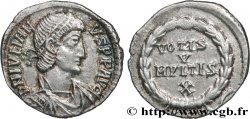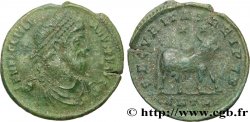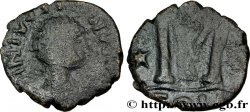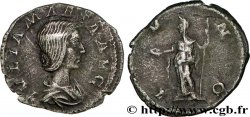brm_289278 - JULIAN II THE PHILOSOPHER Nummus (PBQ, Æ 3)
Not available.
Item sold on our e-shop (2014)
Price : 1 250.00 €
Item sold on our e-shop (2014)
Price : 1 250.00 €
Type : Nummus (PBQ, Æ 3)
Date: c. 361-363
Mint name / Town : Roma
Metal : copper
Diameter : 18 mm
Orientation dies : 2 h.
Weight : 2,45 g.
Rarity : R3
Coments on the condition:
Exemplaire idéalement centré avec une belle et rare représentation au droit. Portraits bien venus à la frappe. Usure régulière au revers. Jolie patine verte
Obverse
Obverse legend : DEO SAR-APADI.
Obverse description : Bustes accolés à gauche d’Isis et Serapis.
Obverse translation : “Deo Sarapadi”, (Au dieu Sérapis).
Reverse
Reverse legend : VOTA P-VBLICA.
Reverse description : Isis debout de face, la tête tournée à droite, tenant le sistrum de la main droite et une situle de la main gauche.
Reverse translation : “Vota Publica”, (Vœux publics).
Commentary
Ce type est l’un des plus rares de ce monnayage, iconographiquement riche mais de la plus grande rareté dans les collections. Ce monnayage remplissait-il un rôle religieux, un rôle politique, un rôle de propagande ? Près de soixante-dix ans après la publication du travail d’A. Alföldi, ce monnayage reste toujours une énigme. Avec son poids de 2,45g, ce type semble particulièrement lourd et correspond parfaitement à une série à part, dont plusieurs exemplaires sont connus (cf. http://www.ancients.info/forums/showthread.php?t=2386) qui semblent taillés au 1/120e de livre.
This type is one of the rarest of this coinage, iconographically rich but of the greatest rarity in collections. Did this coinage fulfill a religious role, a political role, a propaganda role? Nearly seventy years after the publication of A. Alföldi's work, this coinage still remains an enigma. With its weight of 2.45g, this type seems particularly heavy and corresponds perfectly to a separate series, of which several examples are known (see http://www.ancients.info/forums/showthread.php?t=2386) which seem to be cut at 1/120th of a pound
This type is one of the rarest of this coinage, iconographically rich but of the greatest rarity in collections. Did this coinage fulfill a religious role, a political role, a propaganda role? Nearly seventy years after the publication of A. Alföldi's work, this coinage still remains an enigma. With its weight of 2.45g, this type seems particularly heavy and corresponds perfectly to a separate series, of which several examples are known (see http://www.ancients.info/forums/showthread.php?t=2386) which seem to be cut at 1/120th of a pound








 Report a mistake
Report a mistake Print the page
Print the page Share my selection
Share my selection Ask a question
Ask a question Consign / sell
Consign / sell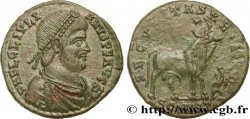
 Full data
Full data